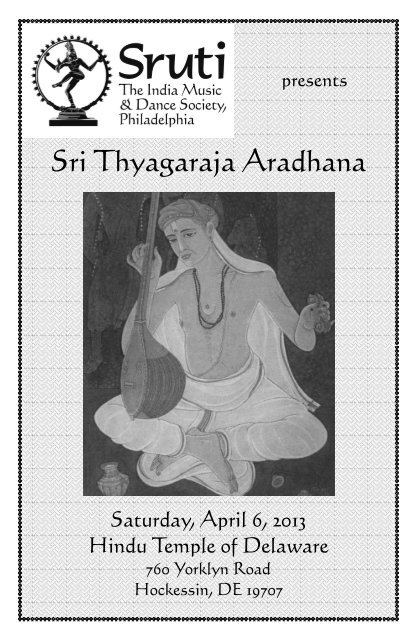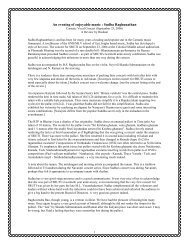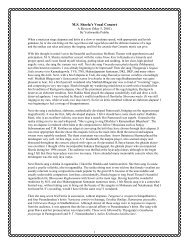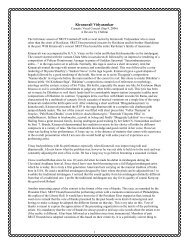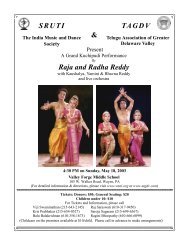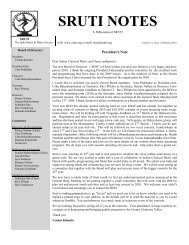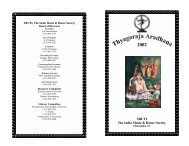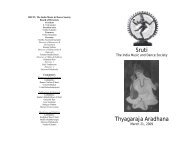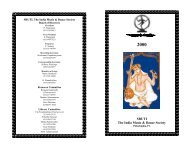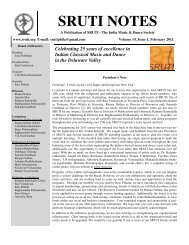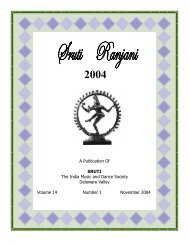Download - Sruti
Download - Sruti
Download - Sruti
- No tags were found...
You also want an ePaper? Increase the reach of your titles
YUMPU automatically turns print PDFs into web optimized ePapers that Google loves.
presentsSri Thyagaraja AradhanaSaturday, April 6, 2013Hindu Temple of Delaware760 Yorklyn RoadHockessin, DE 19707~ ~
Table of ContentsWelcome Note .......................................................................................... 3Today’s Program ...................................................................................... 4<strong>Sruti</strong> Board of Directors 2013 ................................................................... 4What Tyagaraja means to me - Aparna Shankar ................................... 5Test your Tyaga-raga - Vibha Janakiraman ........................................... 7Vidulaku mrokkeda - Vidya Jayaraman .................................................. 8Saint Thyagaraja - Aditi Suresh ............................................................ 12Disciples of Thyagaraja - Anshul Ramanathan .................................... 13Solution for Carnatic Word Search ....................................................... 15Ragas immortalized by Tyagaraja - Harsha Nagarajan ...................... 16Saint Thyagaraja - Prashant Arunapuram ............................................ 18The spread of Tyagaraja’s songs in Karnataka - Naresh Keerthi ....... 20Music Compositions - Rishi Raman ..................................................... 25Stories of Saint Thyagaraja - Priya Badri ............................................. 26Carnatic Crossword - Anika & Sangeethaa ........................................ 27Carnatic Composers Jumble - Shreyas & Hariharan .......................... 28Carnatic Word Search - Keerthana & Sadhana ................................... 30Solution for Quiz, Crossword & Jumble .............................................. 31Spring 2013 Calendar of Events ............................................. Back CoverSRUTI - The India Music and Dance Society is a non-profit 501(c)(3)organization based in the Philadelphia region and founded in 1986. <strong>Sruti</strong>’sprincipal mission is to promote and present Indian classical music and dance.In addition, SRUTI seeks to educate the Philadelphia community at-large aboutIndian arts. SRUTI is a volunteer-run organization. Its leadership comprises anelected Board of Directors and several committees.Every year, around 10 or more world class music and dance recitals arepresented during the Spring and Fall seasons by SRUTI in the GreaterPhiladelphia area. SRUTI also collaborates with other presenting organizationslike the Painted Bride Arts Center, Kimmel Center for Performing Arts,Annenberg Center at the University of Pennsylvania, Drexel University, andMontgomery County Community College.SRUTI has received generous grants from private foundations andpublic organizations including the Pennsylvania Council on the Arts, DanceAdvance and Philadelphia Music Project (funded by the Pew Charitable Trusts)and the Sam Fels Foundation in addition to a loyal and appreciative audience.~ 2 ~
From the Publications & Outreach CommitteeHello Friends,We are excited to join you in raising the curtain for <strong>Sruti</strong> 2013 at ourAnnual Thyagaraja Aradhana Day on 06 April 2013. This day-longevent traditionally marks the beginning of <strong>Sruti</strong>'s spring concert seriesand is a showcase for our local Carnatic music artists and students.This year's featured artist is Shri Ramakrishnan Murthy, who will beaccompanied by Shri V.V.S. Murari on the violin andShri K. Arun Prakash on the mridangam. We also had anoverwhelming interest in the individual and group-singing category thisyear.The Publications and Outreach Committee is commemorating theoccasion with the Aradhana Souvenir. In this release, you are about toexperience Saint Thyagaraja and his immortal gifts through the heartsand minds of the contributors. You will also see that our youngsters,from far and wide, have provided their share, with their articles andpuzzles.We would like to take this opportunity to thank all those who havecontributed to <strong>Sruti</strong>’s publications over the years. We hope you enjoyreading this issue as much as we have enjoyed putting it together.Welcome aboard to <strong>Sruti</strong>’s 2013 programming. Please join us andenjoy the journey through yet another successful <strong>Sruti</strong> year.The Publications & Outreach Committee.Suresh Tyagarajan (Chair)Vidya JayaramanLakshmi Radhakrishnan*Please accept our apologies for any errors or omissions you may find.The opinions expressed by the contributors of articles and reviews arepublished in a spirit of openness of communication and freedom ofexpression. They do not necessarily reflect the views of <strong>Sruti</strong>'s Board or itsmembers.~ 3 ~
ProgramApril 6, 201308:30 AM - Pooja08:45 AM - Utsava Sampradaya & Pancharatna Kritis rendition10:30 AM - Individual Participation12:15 PM - Lunch (Included as part of the entrance donation)01:00 PM - Individual Participation (Continued)02:00 PM - Vocal Concert by Shri Ramakrishnan MurthyViolin:Shri V.V.S. MurariMridangam: Shri K. Arun Prakash04:30 PM - Snack Break05:00 PM - Individual Participation (Continued)07:00 PM - Dinner (Available for purchase from Temple Kitchen)SRUTI Board of Directors 2013President : Ravi PillutlaPresident-Elect : Sunanda GandhamTreasurer: Venkat KilambiSecretary: Madhavi RatnagiriDirector, Resources & DevelopmentDirector, Publications & OutreachDirector, Marketing & PublicityDirectorDirectorRamana KanumallaSuresh TyagarajanNari NarayananUma SivakumarSundar ArunapuramResources & DevelopmentRamana Kanumalla (Chair)Sunanda GandhamVenkat KilambiUma NatarajanViji SwaminathanRaji VenkatesanPublications & OutreachSuresh Tyagarajan (Chair)Vidya JayaramanLakshmi RadhakrishnanMarketing & PublicityNari Narayanan (Chair)Sundar ArunapuramAnwesha DuttaSunanda GandhamRajee PadmanabhanRanjini ShridharUma Sivakumar~ 4 ~
What Tyagaraja means to meAparna ShankarMost people at my school don’t have any idea of who Tyagaraja is. Thatis ironic, because we are at the worldwide hub of Carnatic music, butthey know less about it than a lot of people, Indians and otherwise, in theUnited States.When people are downloading Justin Bieber’s Believe onto their iPods orhumming strains from AR Rahman’s soundtrack of Kadal, I listen toEndaro Mahanubhavulu to get pumped up, or Adamodi Galade torelax, or Chakkani Raja when I’m doing my homework. Why?When people are burying their heads in textbooks during exam-time, Iwish I could be in two places at once, the exam hall and Tiruvaiyaru forthe Tyagaraja Aradhana. During the December holidays, when people flyout of the country to places they’ve only seen in movies, I sitmesmerized in a concert hall hoping the next song is any Tyagarajafavourite of mine. Why ever?Tyagaraja’s music is special. It can make you smile, cry, sleep, wake up,close your eyes or wave your hands about without knowing it. It canchange your mood. It can make your day. The music is that of a maestro.The words are those of a supreme devotee. Still, you can feel theconnection with it instantly. There is also an x-factor to it which is beyondanalysis.Last year, I was lucky enough to visit his birthplace in Tiruvarur and hisSamadhi in Tiruvaiyaru. Both were moving experiences. In my life, I wantto cover everything in between – learn as many of his hundreds of songsI can, find out the stories about them, be where he’s been and know howhis mind worked.The Trinity of Carnatic music have been analysed in many ways. One isthat Tyagaraja’s songs are like grapes – easy to understand and enjoy.Syama Sastri’s are like a banana – one layer of unpeeling is required.Muthuswami Dikshitar’s are like a coconut – you have to work hard torelish it, but you are rewarded. I don’t like to think that I like Tyagarajaonly because I can only understand simple things. There is so muchmore to him – and my tastes.Another broad comparison is that Tyagaraja is associated with bhava,Syama Sastri with tala and Dikshitar with raga. This is very general andmay help entry-level rasikas, but each has lots in store to overturn this.There are more intelligent comparisons though. Dikshitar’s words, inwhichever context they were created, are always neutral and the mood~ 5 ~
of the song is completely conveyed by the raga. (In other words, thesinger of the song has the responsibility of making the right mood comethrough) Tyagaraja’s, on the other hand, bring out the emotions in hismind. This is coupled with the handling of the raga to produce a stunningeffect.However, they make no specific mention of the context, so they make asmuch sense in a concert as any other song. For example, when hisbrother threw his Rama idol away in anger, he composed the songNenendu Vethukudura – the song of a man searching for God. But thatsong could be of anyone in his search for God - it is addressed not to amissing idol but to the Supreme God yet to be realised. The same is forthe song composed when he found the idol – it is a song of divine joy.Tyagaraja had employed different types of devotion in his songs –praising the Lord; portraying oneself as a wretched sinner; and salutingall the great people who have lived. He was a versatile composer andexpressed himself freely in his language of choice.During the Tamil Isai movement, there was a strong feeling againstsongs not in Tamil. I cannot express in words how happy I am that someof the ludicrous ideas of the time were never implemented, liketranslating his songs into Tamil and retaining the tune. Narrow regionalmindednesshas no place when dealing with greats.I belong to the Dikshitar school of music and however much I love bothschools, I cannot bear to see one dominate the other. Tyagaraja’s raganaming system, for example, has a few differences from Dikshitar’s(I won’t go into it – there can be an hour-long lecture on it) butTyagaraja’s system is in control and Dikshitar’s is in danger of beingstamped out from consciousness. While being overawed byTyagaraja’s genius, another should not be compromised on.Whatever be the controversies, Tyagaraja’s music will always be afavourite of mine which I, and anyone else, can turn to. It hassomething for all moods and all types of people. I invite you to tell anyfriend of yours ignorant of Carnatic music to leave his prejudicesbehind and experience the magic of the bard from Tiruvaiyaru.Aparna Shankar is a 9th grader who lives in Chennai, India and learnsvocal music and veena from Srimathi Jaysri Jeyaraaj Krishnan~ 6 ~
Test Your Tyaga-ragaA quiz on some of the ragas popularizedby the compositions of TyagarajaVibha Janakiraman1. I am a janya of DhirasankarabharanamI am a vakra raga without dha or a ni while going uprggrR gives me my life2. With vakram up not downI don't have ga or ri22 OR 28 both my family3. I don't have the 5 th noteThe sun and moon give me my name4. I am a sampurna, shadava ragaI come from the 60 th mela5. I am audava without ri and niI appear when you do grahabedham onhamsadwani's pancamam6. I do not have maIf you take out my riI become Valaji7. I have prati madhyamamI come from the 60 th melaI have a dha, but I am much more popular without it(Solution on Page 31)Vibha is a second grader at Chaddsford Elementary School and lives inWest Chester.~ 7 ~
Vidulaku mrokkedaVidya JayaramanA characteristic feature of Indian traditions including classical arts is thatwriters, composers and practitioners do not claim singular ownership ofknowledge. The very notion of originality and ownership of knowledgewithin the Indian art traditions rests on a system rooted in guruparampara. In the Indian textual tradition, this is made clear bystatements like “vayam tu vakṣyāmaḥ” (We say this) and“asmad gurumate” (In our school) rather than a system of “This is myidea” or “I say this”. Thus, writers of most śāstraic works in Saṅgītabegin with a salutation to their predecessors or pūrvācārya-s. Thisserves the two purposes. It marks the expression of gratitude for thelearning bestowed and it establishes the continuity of tradition where thecomposer/writer/artiste acquires his or her own place as a "link" in anunbroken chain. Ācārya Abhinavaguptapāda the polymath commentatorof the Nāṭyaśāstra says,urdhvordhvamāruhya yadartha tatvam dhiḥ paśyati śrāntim avedayantiphalam tadādyaih parikalpitānam viveka sopāna paramparāṇāmClimbing ever higher and higher, knowing no repose the intellectperceives the truth of thingsThis is the reward of treading the rungs of discrimination on the stairwaybuilt by generations of forerunnersGiven this background, how did a composer in the 18 th century look atthis worldview? Scholars say that the main difference between theapproaches of Tyāgarāja and Muttusvāmi Dīkṣitar was that Dikṣitarresurrected old raga-s and gave life to them by composing in them whileTyāgarāja shaped the music of the future as a mārgadarśi. He boldlypushed frontiers and broke new ground in music, whether it was in hisapproach in fashioning ragas out of the skeletal varja and vakra ragascales or his adoption of the (then) new system of heptatonicmelakarta-s, or his attitude towards vivādi rāga-s. We also find thatTyāgarāja saw himself as a link in the same parampara. Tyāgarāja thus,reflects upon his musical predecessors in the composition‘Vidulaku mrokkeda’ aptly set in the rāga Māyāmālavagaula.The Pallavi simply begins with a simple salutation to ‘kovidulu’ - thelearned in music and the anupallavi qualifies the kind of musicians andtrendsetters he salutes as the knowers of the sāmaveda and those thatunderstand the intrinsic nadātmakatva of the seven svaras. Havingclarified their characteristics, he unravels the plot further in theCaranam, which at first glance simply reads like a roster of names. Ithought, it would be an interesting exercise to reflect on the question,~ 8 ~
“Where did the composer find these names and what was it that they didto find themselves a place in Tyāgarāja’s list”..Kamalā- gauri- vāgīśvari-vidhi-garuḍadhvaja-Śiva-amareśa-guhagajamukhuluThe first group consists of the celestials – Lakṣmi, Pārvati, Sarasvati,their consorts Brahma-Viṣnu-Maheśvara, Śiva's sons - Gajamukha andṣanmukha, and Indra the leader of the devas. These names do not needan introduction. The next group comprises celestial sages, ancientseers, a gandharva and two devotees who were promoted to Godhood -Nārada, Bharata, Kāśyapa, Mārkaṇḍeya, Agastya, Tumburu, Añjaneyaand Caṇḍīśa.Nārada and Tumburu:Nārada is a familiar figure to us atleast in his puranic wandering bardidentity. He is invariably placed alongside a musical rival - gandharvaTumburu in several stories. We also have the tales of contests betweenNārada and Tumburu and the story from the Adbhuta rāmāyaṇa of howNārada was taught a lesson in humility when he saw a bunch ofmutilated forms outside the place where he practised. It was laterrevealed to him that they were the forms of the raga-s that were sung byhim in incorect form. There are also musicological treatises attributed to‘Nārada’. The earliest is the Nāradiya śikṣa and there is also a medievalwork named Saṅgīta Makaranda. Quotations attributed to Nārada arefound in many Saṅgīta texts. Locana Kavi in the text Raga Taraṅgiṇinames a text “Tumburu Nāṭaka” and says that this text gives theperformance times of each raga. The commentator of theSaṅgītaratnākara Kallinātha also quotes verses from Tumburu. Withseveral compositions by Tyāgarāja on Nārada and the legacy ofTumburu as a musician, it is no wonder that Nārada and Tumburu find aplace in Tyāgarāja's roster.Bharata:Bharata is the celebrated author of the Nāṭyaśāstra. In the time ofBharata, ‘nāṭya’ encompassed music, dance and instruments functioningwithin the ambit of theater. The Nāṭyaśāstra has six chapters that dealwith string instruments, melodic classes, percussion instruments andmusical forms though music is treated in that text as subservient totheater as a whole. A few centuries before Tyāgarāja, dance and musichad bifurcated, yet even texts that exclusively discuss music saluteBharata. It is the one text which every subsequent treatise writer quotes,paraphrases, reproduces, and rephrases. So too does Tyāgarājamentions Bharata.~ 9 ~
KāśyapaKāśyapa is familiar to us as a muni or sage. But what is his connection tomusic? Though we do not find any works on music attributed directly toKāśyapa, there are many quotations attributed to him from other texts.Sarṅgadeva pays obeisance to him in the beginning of his work. ĀcaryaAbhinavagupta gives eight anuṣtup verses on the tunes that were usedfor various bhava-s and rasa-s and attributes them to Sage Kāśyapa.Kāśyapa is also quoted by King Nānyadeva in his Bharatabhāṣya. He isalso referenced in Saṅgīta Makaranda and is said to have authored twoworks. Unfortunately none of his works are available.Añjaneya:Añjaneya's identity as the supreme bhakta and messenger of Ramawould have no doubt endeared him to Tyāgarāja and like Nārada, wehave compositions like gītārthamu specifically in praise of him. Traditionalso states that Añjaneya was an expert in grammar (nava vyakarananipuna) and Saṅgīta. In terms of the textual tradition, Añjaneya's schoolor Añjaneya mata is indicated in texts such as Saṅgītapārijāta andSaṅgītasudha wherein he is referred to as a teacher who enumeratedrāga-s and rāginis and also as an authority on deśirāga-s.MārkaṇḍeyaMārkaṇḍeya’s encounter against yama is a familiar tale. Yet, it issurprising that Tyāgarāja refers to him as one of the Saṅgītakovidulu, forwe do not have any primary text on music that quotes him or makes areference to him. However we must remember that musical informationdoes not always come to us from primary sources. There are manyterms and musical references in different genres such as kāvya, itihāsaand the purāṇa-s. The Mārkaṇḍeya purāṇa, Viṣṇudharmottara purāṇa,and Vāyu purāṇa have interesting snippets of musical information.Mārkaṇḍeya Purāṇa has a reference to the story of two nāga brothers’,Kambala and Aśvatara worshipping Śiva through music and theiracquisition of the art due to Sarasvati's blessing. The text lists out thetopics such as saptasvara-s, grāma rāgas, the tālas, and the three laya-sand giti-s (songs) that the brothers learn. We could perhaps concludethat Tyāgarāja was familiar in puranic lore and thus adds a deliberatereference to the son of Mrkaṇḍu muni here.AgastyaKumbhaja means ‘one born of a pot’ and is one of the names of SageAgastya. Sage Agastya in the Tamil tradition has traditionally beenassociated with music and is said to have created both Tamil grammarand music. In the pancamarabu, a text with some of its contents placed~ 10 ~
in the Chola period (and from which we find references in theCommentary of the Cilappatikāram) the author Cerai arivanār salutesAgastya who lived in the Podhigai malai. There are not too manyreferences to him in the Sanskritic tradition. We also find a Telugu textnamed RāgaTālaCintāmani invoking Kumbhaja. The reference to thistext is also interesting in that this is a text (perhaps the only one), whichspeaks of the birth of the saptasvara-s from the heads of Sadāśiva -another idea employed by the composer in nādatanumaniśam. There arealso traditional mythological tales of Agastya vanquishing Rāvaṇa in acontest on the vīṇa. Tyāgarāja refers to Agastya singing the praises ofSita in the krti ‘Dehi tava pada’ in sahāna rāga, where he says, and“kalaśaja gīta mudite”. Perhaps this composition was Tyāgarāja'simaginative take off based on the conversation in Vālmiki Rāmāyaṇawhere Rāma, Lakṣmana and Sīta visit the āśrama of Agastya andAgastya praising Sīta's decision to accompany Rāma to the forest.NandiNandikeśvara has the familiar identity of the mount of Śiva and as aspecialist in percussion. We also have references to the school ofNandikeśvara and the Abhinayadarpaṇamu used by dancers today as amanual is attributed to a Nandikeśvara. There is also a quotationattributed to Nandikeśvara in the text of Brhaddeśi of Mataṅga withregard to the topic of murchhanas. There is a work on music by aNandibharata and another work named Bharatārṇava, which is set in theform of a dialog where Nandi teaches a king named Sumati. There arealso treatises on tāla attributed to Nandikeśvara.Finally we have the last group – the two mortals that Tyāgarāja speaksof: Someśvara and Śārṅgadeva.Śārṅgadeva is the author of the Saṅgītaratnākāra, a text which is similarto the Nāṭyaśāstra in being a very-well-cited work in both North andSouth India. Śārṅgadeva too invokes his predecessors beginning withSadāŚiva – perhaps the very model that inspired Tyāgarāja.Someśvara – This is a name which is somewhat ambiguous.Śārṅgadeva too refers to Someśa. In terms of Tyāgarāja’s usage, itcould be a reference Someśvara - the Chalukyan king and the author ofa work named mānasollāsa. The mānasollāsa or Abhilāṣārthacintāmaṇiis an encyclopaedia where musical topics also find a place.According to Dr.V.Raghavan, there is also another Someśvara, theauthor of a work named Saṅgītaratnāvali. Thus it is unclear whetherTyāgarāja borrowed the name from the Ratnakara or perhaps due to themulticultural environment of Tanjavur, Tyāgarāja was familar with the~ 11 ~
mānasollāsa or if he was familiar with the author of Saṅgītaratnāvali.The one name which I have not been able to find any musical referenceis that of Caṇḍīśa. Caṇḍīśa is the ever-alert attendant of Śiva watchingfor transgressions and the accepter of nirmālya in South Indian temples.As per the account of the Periyapurāṇam, he was named Vicāraśarmanand was a vaidika by birth who tended cows. He was a devotee of Śivaand punished his own father for denigrating Śiva and thus was promotedto the place of an attendant. There seems to be no reference to music inany of these accounts in the Tamil or Sanskritic or other traditions.It is an interesting and valuable exercise to reflect on the reflections ofTyāgarāja in terms of his approach to Saṅgītasastra, for, he himself saysthe knowledge of Saṅgītasastra leads to sārupya and happiness. It alsoenables us to understand that ‘tradition’ and ‘innovation’ were notopposite sides of the coin and how societies understood knowledge andhow change and innovation sustained tradition.Vidya Jayaraman lives in West Chester. Her interests include IndianPhilosophy, Tamil/Samskrtam studies and Music.Saint ThyagarajaAditi SureshThe origins of Carnatic music, the renowned style of Indian classicalmusic of South India, can be traced back to the twelfth century. But itwas not until centuries later that the musical tradition was greatlyadvocated and upheld, and a humble man born in the Thiruvarur districtof Tamil Nadu played an eminent role in the sustenance of this musicform. Today, he is widely known and praised as Saint Thyagaraja.Before he was even born, it is said that the highly acclaimed composermade his mark on the world. His parents, Kakarla Ramabrahmam andSitamma, foresaw his birth in a dream. After being welcomed into theworld, Saint Thyagaraja was named after Lord Thyagaraja, the presidingdeity at the Thiruvarur temple. Thyagaraja’s grandfather, Giriraja Kavi,was a composer in the court of the King of Thanjavur, so highexpectations were held for the young boy. But he would soon prove to bea musical prodigy and impress even his musically talented elders.Under the tutelage of Sri Sonti Venkata Ramanayya, Thyagaraja’sdexterous gifts were kindled, and he started composing music at a veryyoung age.An ardent devotee of Lord Rama, Thyagaraja composed most of hismusic on the god, and news of this scholar spread rapidly. The king of~ 12 ~
Thanjavur invited Thyagaraja to his court, but Thyagaraja declined, notwanting to be a spectacle but rather a humble disciple of the Lord.Taking on a life detached of materialistic possessions, Thyagarajaspread his name across Southern India, travelling everywhere singingthe name of the Lord.In his lifetime, Saint Thyagaraja was able to create over 700 brilliantcompositions, and to this day, we sing them in his honor. Although wewill never know the exact count of his songs due to the lack of records inthat time period, students of Saint Thyagaraja managed to pass on hisworks from generation to generation. His most famous songs, thePancharatnam Kritis, are sung in praise of him during the exaltedThyagaraja Aradhana held every year in Thiruvarur. Singers from all overcome for the festival. Today, other Thyagaraja Aradhanas are held allover the world.Saint Thyagaraja is a musical legend and was greatly influential in thedevelopment of Carnatic music. His feats made him an exceptionalindividual whom we can only aspire to be. There are a number ofmiraculous stories told of his lifetime, such as that he encountered SageNarada or was the reincarnation of Sage Valmiki himself. By keepingSaint Thyagaraja alive through his music, we can preserve the sacredmusical tradition for generations to come.Aditi Suresh is a 10th grader in the West Chester Area School District.She has been passionately learning Carnatic music for the past 11 yearsunder the tutelage of Smt. Lata Suresh.Disciples of ThyagarajaAnshul RamanathanSaint Thyagaraja, also referred to as Thyagabrahmam, revolutionizedCarnatic music. Thyagaraja’s fame and popularity brought him manydisciples. He had 30 direct disciples, who contributed to preserving hismusic. Three branches of his Sishya parampara (line of disciples) -Umayalpuram, Tillaisthanam and Walajapet - are worth mentioning.If it weren’t for his disciples, Thyagaraja would probably not have beenas renowned to this generation.Walajapet Venkataramana Bhagavatar (1781-1874) was one of the mostimportant disciples of Saint Thyagaraja. He and his son, WalajapetKrishnaswamy Bhagavatar belonged to the Walajapet school/sishyaparampara. The single most significant contribution of the Walajapetfather and son pair was the collection of Thygaraja’s available krithis.From these records, we come to know that Thyagaraja wrote threeoperas - Prahlada Bhakti Vijayam, Nauka Charitram and Sita Rama~ 13 ~
Vijayam. Walajapet Venkataramana Bhagavatar was a scholar inSanskrit and Telugu, and he composed slokas and kritis praising hisguru.Sri Guru Stotra-ashtakam in SanskritSri Guru Managalashtakam in TeluguAdi Guru Stotra panchangam in TeluguA Manipravalam poetry -in Sanskrit, Telugu and SourashtraGurucharanam bhajare - ShankarabharanamGuruvaru mahimala - AnandabhairaviThyagaraja left behind his puja idols, Rama Padukas and his tambura inthe care of Venkataramana Bhagavatar, his most trusted disciple. Thefather and son have passed down Thyagaraja’s legacy to their students.The other line of disciples is the Tillaisthanam School, governed byRama Iyengar. He is regarded the ‘antharanga sishya’ of SaintThyagaraja. Rama Iyengar was the master of singing kalpanaswaras.Rama Iyengar started the religious functions of the Aradhana during histime. In 1908, the disciples of Thillaistham Narasimha Bhagavatar andhis younger brother Panchu Bhagavatar started the five-day aradhanafestival that included many concerts. Narasimha Bhagavatar alsopublished a composite collection of Thyagaraja's songs in 1908. Thereligious part of the aradhana celebrations is continued even today.The Umayalpuram School was represented by two brothers- Sundaraand Krishna Bhagavatars. The Umayalpuram brothers continued theAradhana in their native village. According to the Umayalpuram tradition,it is believed that Thyagaraja embarked on the great Tapas of recitingRama Nama ninety-six crore times and it took him twenty-one years andfifteen days to finish this Japa. At the end, Thyagaraja had the dharshanof Sri Rama and he sang his first piece, Elanldayaradu in Atana. Thebrothers employed a “lecture-recital” format to bring the songs to Tamilaudience. In 1905, the Umayalpuram brothers renovated the Samadhi ofThyagaraja with public donations and arranged for daily worship at thesite.Though there were two factions, Thillaisthanam and Umayalpuram, theAradhana was carried out smoothly, with one faction doing the festivalthe first 5 days and the other faction hosting the festivals the next 5 days.Musicians participated in both aradhanas.The disciples of Thyagaraja played huge roles in carrying his legacyforward. Without Walajapet Bhagavathar, we would not have the recordsof Thygaraja's life. In addition, we would not know about his many krithis.They formed a school and taught their students many compositions by~ 14 ~
Thygaraja. The Thillaistanam and Umayalpuram schools performedseveral aradhanas in honor of Thyagaraja and his wonderfulachievements. These aradhanas are so popular they go on even to thisday.The brothers have had a huge impact in the musical society by creatinga Thyagaraja Aradhana. It is because of these disciples that we are ableto cherish Thyagaraja’s compositions and are able to bequeath his greatlegacy.Anshul is a 9th grader studying at Council Rock High School North. He islearning carnatic music from Mrs. Uma Sivakumar.Solution to Carnatic Word Search on Page 30~ 15 ~
Ragas immortalized by TyagarajaHarsha NagarajanAs we all know, Tyagaraja has been undoubtedly the most influentialcomposer in the annals of Carnatic music. His influence on music andmusicians over the last 150 years has been considerable primarily due tohis musical genius which are apparent through his (approximately) 700compositions in about 210 rAgAs. Tyagaraja was a trend setter in theuse of simple words for his compositions packed with immense amountof bhAva (emotion), which is probably why his compositions arecompared to “drAksha rasa” – we can immediately feel the taste, themoment we put a drAksha (grape) in our mouth.Among the 210 rAgAs, around 82 rAgAs hadn’t existed before his times,which he himself classified them as “vinta rAgAs” (“vinta” is Telugumeans rare or extraordinary) and most of these being janya rAgAs.Some of the popular vinta rAgAs include AndOLika, bahudAri,bindumAlini, hamsanAdam, kalyANavasanta, kApinArAyaNi,naLinakAnti, sAramati, supradIpam, saraswati, etc.Tyagaraja also seamlessly invented many vakra (tortuous) rAgAs whichare highly bhAva laden. His musical acumen comes to the limelightthrough his inventions of vakra sampUrNa rAgAs having entirely differentcharacters, though born out of the same janaka (parent) rAga. A classicexample for this would be mALavi (Aa: S R2 G3 M1 P M1 D2 N2 S,Av: S N2 D2 P M1 G3 M1 R2 S) and chenchu kAmbOji (Aa: S P M1 G3M1 D2 N2 S, Av: S N2 D2 N2 P M1 G3 R2 S), hari kAmbOji being theirjanaka rAga. Also Tyagaraja was the first to break the rule of having atleast 5 notes in the ArOhaNam of any janya rAga and came up withrAgAs like vivardhini (Aa: S R2 M1 P S) and navarasa kannaDa(Aa: S G3 M1 P S), both with just 4 notes in the ArOhaNam.Apart from these short rAgAs, Tyagaraja also immortalized many otherrAgAs through his multiple compositions in each rAga, because of whichthese rAgAs got promoted to a major rAga status. Some of them includevarALi, mOhanam, darbAr, bilahari, dEvagAndhAri, mukhAri, etc.Tyagaraja also pioneered in the mELakarta rAgAs through his prolificcompositions in shankarAbharaNam (29 songs), tODi(28 songs), kalyANi(20 songs), kharaharapriya(13 songs) and so on. Let us look at some ofthese rAgAs.shankarAbharaNam: Tyagaraja has gifted the world with about 29songs, all different in melodic structure, each outlining a different aspectof the rAga and has coaxed the rAga to probably yield all kinds of rasAs.The very popular enduku peddhala, the philosophically advaitic~ 16 ~
manasu svAdhInamai, the cauka kAla masterpiece Emi nEramu, theevergreen swararAga sudhA rasa, bhakti bhikshamiyyavE wherein thebard pleads to Rama to grant him devotion as alms and budhirAdu,wherein the saint moans the silly and stupid ways of the world, etc. Hehas also composed a number of divya-nAma kIrtanAs in this rAga.tODi: Among the composers, Tyagaraja perhaps has the most prolificcollection of compositions in tODi. As though to illustrate that everyswara in tODi can be considered a graha swara (an important note in therAga from which AlApana can be begun), Tyagaraja has composedcompositions beginning in swarAs ranging from mandara dhaivata(dAsharathi) to tAra stAyi shaDja (koluvamaregada). Also, the brilliantand appropriate usage of the jArus (glides) and gamakAs (oscillation) ofthe notes in his compositions have lead to the possibilities of variouskAla pramANAs (speeds), ranging from chauka kAla krithi(kaddanu vAriki) to a brisk madhyama kAla krithi (kOTinadulu). Theartistic device of sangathi (gradual improvization of a simple musicalphrase) is another of Tyagaraja's original ideas which can be lucidly seenin the way he has sculpted the sangathIs in the pallavi of “chEsinadella”.kharaharapriya: Tyagaraja and kharaharapriya are so synonymous thatit wouldn’t be an exaggeration to say that, today’s existence of thisabsolutely magnificent rAga is purely due to this saint’s compositions.The three canonical krithis, “chakkani rAja mArgamu”,“rAma nI samAnamevaru” and “pakkAla nilabaDi” distill the magnificenceof this rAga in all its splendor. Tyagaraja’s kharaharapriya was socaptivating that even the legendary Hindustani musician, Ustad AbdulKarim Khan (founder of kirAna gharAna) recorded“rAma nI samAnamevaru” in the early 90’s.Also, Tyagaraja was arguably the first to compose and show the melodicrichness and possibilities of other mELakartAs like dhEnuka(teliyalEru rAma), vakuLAbharaNam (yE rAmuni nammitinO), rAmapriya(kOrinavara), cakravAkam (eTula brOthuvu & suguNamule),sUryakAntam (muddumOmu), jhankAradwani (phaNi pathi shAyi),kIravANi (kaligiyuNTe), gowrimanOhari (gurulEka), sarasAngi(menujUchi), vAgadIshwari (paramAthmuDu), etc.bilahari: Tyagaraja has composed as many as 10 krithIs in bilahari rAgathough the rAga is relatively a minor rAga. He is the only composer tohave attempted so many krithIs in this rAga. Amongst his compositionsin bilahari, “nAjIvAdhAra” and “dorakuna iTuvaNTi” shine as resplendentgems. The beautiful usage of sanchAri alankArAs, jaNTa swarAs anddATu swara phrases can be observed in the sangathIs of dorakuna’spallavi.Similarly, Tyagaraja has embellished many more rAgAs in his own~ 17 ~
inimitable style, as well as introduced several of his own to the musicaluniverse. While this article attempts to serve as a glimpse into thisuniverse, the only true way to enjoy, appreciate and understand his workis to immerse oneself into his compositions. It would amount tojanmasAphalyam if one could attain the state of truly understanding thegenius of the sage of Tiruvaiyyaru.References:1. “Sangita Sampradayam - A collection of lectures on Carnatic music” (Vol−2) -R.Vedavalli.2. “South Indian Music” - Prof. P. Sambamoorthy.3. “Tyagaraja’s contributions to Art Music” - M.V. Ramana, V.N. MuthukumarHarsha Nagarajan had his initial training in Carnatic classical musicunder Shri. Paramashivan & Shri. D.V. Nagarajan in Bangalore, India.He continued learning from Shri. R.K. Padmanabha. Harsha has beenundergoing advanced training from Shri. T.K.V. Ramanujacharyulu. Hemoved to the US in 2006 and since then, he has been performing concertsat various venues both in India and the US, including the DecemberMargazhi seasons since few years. Harsha is currently the president ofSociety for Promotion of Indian Classical Music and Culture AmongstYouth (SPICMACAY) - Texas A&M University chapter. He is currently aPhD student in Mechanical engineering at Texas A&M UniversitySaint ThyagarajaPrashant ArunapuramSaint Tyagaraja is one of the most renowned musicians in all of Indiaand is hailed by most as the best composer in Indian history.Tyagaraja was third son of Ramabrahmam and Seethamma, and he wasborn on May 4, 1767. The place of his birth is not clear, as some say hewas born in Thiruvarur in the Tanjavur district in Tamil Nadu, while otherreports say that he was born in Andhra Pradesh and later moved toThiruvarur. He lived most of his life in Tiruvayar, Tamil Nadu. Hisfather, Ramabrahmam, was a great devotee of Rama, and was veryhappy to see that Tyagaraja also followed his footsteps. He showed asimilar devotion to Rama and was encouraged to sing devotional songs.Tyagaraja’s maternal grandfather was Giriraja Kavi, a renownedpoet-composer for the Thanjavur king. Thus, Tyagaraja inherited hisdevotion to Rama from his father and his gift for poetry and music fromhis maternal grandfather. When he was 13 years old, Tyagaraja sanghis first composition “Namo Namo Raghavayya” in Desikathodi, whichimmediately demonstrated his skills for composing, talent for music, anda strong devotion to lord Rama.Tyagaraja began his formal music training under Sri Sonti VenkataRamanayya, and it was immediately obvious how much of a scholar he~ 18 ~
was. He practiced music purely for the devotion to God. After a fewyears, his teacher invited Tyagaraja to perform at his house. This iswhen he sang the famous first Pancharatna Kriti –Endaro Mahanubhavulu. Upon the recommendation of Sri Sonti VenkataRamanayaa, Tyagaraja was invited to the royal court as a musician, buthe rejected the invitation because he did not want any fame or wealth.This is when he composed the song, Nidhi Chala Sukhama where hecompares pleasure from wealth to pleasure from service of god.However, his rejection of royal invitation angered his brother, whobelieved that Tyagaraja singing at the royal court would earn them somemoney. He threw the statues of Rama that Tyagaraja worshipped in theriver Kaveri. Tyagaraja was so upset that his Rama’s idols were missingthat he composed many sad kritis about Rama because he could notbear the separation. He made pilgrimages to many temples to stay intouch with his Lord, and he composed songs about the deities in thosetemples.There are about 800 known compositions of Tyagaraja, but there may bemore because many of the songs that he sang were not written down.His disciples followed wherever he went and wrote most of hiscompositions in palm leaves. However, it is believed that manycompositions of his were either not recorded or destroyed. Throughouthis songs, Tyagaraja incorporated over 200 ragas in his songs. He alsosang songs in around 60 new ragas. Almost all of his compositions werewritten in his mother tongue, Telugu.All of his songs combined bhakti as well as bhavam, giving deepmeaning and spiritual emotion to his songs. In one of his songs“Ksheera Sagara Sayana,” Tyagaraja describes Lord Vishnu reclining ona snake in the ocean of milk. When Tyagaraja describes that, hepurposely avoids the use of gamakam on the word “sayana”, as he didnot want to disturb Him in his state of relaxation. However,“Ksheera Sagara” has many gamakams and variations, representing thegentle waves of the ocean.In addition to his compositions, he also wrote some plays such asPrahalada Bhakti Vijayam and Nauka Charitram. These plays hadmultiple kritis in various ragas providing powerful commentary on ways ofreaching the Supreme Lord through Bhakti or devotion.Prashant is a 11th grade student at Henderson high school. He hasbeen learning carnatic vocal music since 2004 under the guidance ofMrs. Lata Suresh and also takes Piano lessons from Mrs. HazelSorenson. His after school activities include science olympiad, mathclub, academic team and tennis team. Outside of school, he loves toplay chess and read about space and astronomy.~ 19 ~
The spread of Tyāgarāja’s songs in KarnātakaNaresh KeerthiThe compositions of Tyāgarāja have been a major unifying / bindingfactor for practitioners of Carnatic music all over South India in the lasttwo centuries. His compositions, because of their sheer diversity andrange in terms of melodic complexity, compositional variety, lyricalcontent and rhythmical intricacy had something to offer for everyone –from the neophyte singer in a bhajan group to a sophisticated courtvidwAn. This, coupled with a well populated and well spread outgenealogy of disciples (shishya paramparā) may have been responsiblefor the successful spread and establishment of the songs of Tyāgarāja inSouth Indian musical traditions.Here is an attempt to investigate the spread of Tyāgarāja’s songs inKarnataka (erstwhile Mysore state) and also extend the study to explorethe lineages, repertoires and stylistic differences in the performance andpractice of Tyāgarāja’s songs in Mysore / Karnātaka, limiting the study tothe period 1850-1950.The major nodes considered are Mysore Sadāshiva Rao, BidāramKrishnappa, Sangita Kalānidhi Vāsudevācārya and Sangita KalānidhiRāllapalli Anantakrishna Sarma (henceforth Sarma). A few other sourceshave also been considered based on available information anddiscography.Sadāshiva RaoVery few biographical details are available about the talented singercomposerSadāshiva Rao. The tyāgabrahmOpanishad, Subbarāmadiksitar’s vāggeyakāracaritamu and internal evidence from his songssuggests that he was a disciple of Wālājapet Venkataramana bhāgavatar[kRpa jUDa rā - kiraNāvaLi], and had opportunity to meet Tyāgarāja,during the latter’s pilgrimage to kānci, when he made a detour toWālājapet to visit the Sitārāma bhajana mandira built by Venkataramanabhāgavatar with the help of the local Cettiyar tradesmen (vartakulu).Similarly, internal evidence suggests that Sadāshiva Rao came toMysore in the time of Krishna Raja Wodeyar III (1794 –1868). His primedisciples were VINE SubbaNNa and vINE SheSaNNa; who disseminatedhis stock of compositions through their performances and through theirstudents. Sadāshiva Rao was responsible in large part, for theestablishment of a several songs into Mysore, in an enduring fashion;and a significant chunk of songs that he introduced were those ofTyāgarāja.SheSaNNa (1852-1926) has given a record of Mariyāda gādura inSankarābharanam (a Wālājapet specialty, also notated by Subbarāma~ 20 ~
Diksitar) and his collection of songs was inherited by Venkatagiriyappa.Veena Venkatagiriyappa published a book, which was meant to be theofficial ‘textbook’ for schools students who chose music as an optional. Itis simply amazing to see the rich stock of songs represented here.Beside several varnas of musician from Tanjore and Mysore, (includingsome of the author!) the text included the mohana ‘pedda varnam’sariga dAni of KārvETinagaram gOvindasAmayya. The notationindicated that this is from an oral tradition slightly different from thatnotated in the Sangita Sampradāya Pradarshini (1904). Songs includedin VenkaTagiriyappa’s book include Raghunandana inSuddha dEshi, Manasā etUlOrtunE with a yati-prāsa normalized versionof the pallavi and kaTTu jEsināvO in aTāNa.Sangita Kalānidhi Doreswami Ayyangār used to play a version ofmanasā mana sāmarthyamemi in Vardhini, which is quite different fromthe prevalent, popular linear treatment of vardhini; which he inheritedfrom his guru Venkatagiriyappa.Bidāram Krishnappa (1866–1931)We do not know the sources for Krishnappa’s stock of songs, but helearnt many songs from the senior musician Karigiri Rao. He has given78 rpm records of Kanugonu saukhyamu (nāyaki) and Emi nEramu(Sankarābharanam). He was known for his rendition of DhyānamEvaramai in dhanyāsi, which enraptured a young Anantakrishna Sarma,and led him to seek Krishnappa’s tutelage.Among Krishnappa’s students, Chikkarāma Rao (1891 – 1945) has givena record of nI dāsānudāsudanu (Yamuna kalyāNi,dEsAdi) andkarunajUDavayya (sāranga). Chowdiah was fond of playing theVivardhini piece, and has given a 78 rpm record each of callaga nATO(vEgavāhini)[ Columbia, GE 426] and nI dAsAnudAsudanu inHamir KalyAni.Rāllapalli Anantakrishna Sarma (1893 – 1979) – An ekasandhagrāhi,Sarma learnt from Bidāram Krishnappa and Karigiri Rāo at Mysore, butamassed an incredible repertoire of compositions of the trinity andpre-trinity composers, padams of ksetrayya, Govindasāmayya andsārangapāNi, as well as the songs of pallavi doraswāmayya and Pallavigopālayya. Sarma was a rich repository of hundreds of traditional songs– suvvi, lāli, hārati, bhajans, pUja songs and marriage songs; and oftenused them as illustrations for rāgalaksaNa. He would demonstratesaindhavi and dwijAvanti using mangalams that he learnt in hischildhood, rather than through later compositions. He is of course bestknown for his reconstruction of annamayya’s sankirtanas in the rāgasspecified by the composer.~ 21 ~
I have had an opportunity to study the musical repertoire of R.A. Sarmain detail, through the kindness of my teacher Smt. R.A.Harini, who is adaughter and disciple of Sarma. Smt. Harini had the opportunity toclosely observe Sarma’s lessons and imbibed his style and repertoirebeyond the songs that he personally taught her. It is amazing to noticethe expanse of Sarma’s Tyāgarāja repertoire. Beside uncommonpAthAntaras with exquisite sangatis, of several well known songs, thefollowing near-extinct songs feature in the Sarma set.It may have been because of his literary inclinations, or because of hisvāggEya-hRdaya, a striking feature of the rāllapalli legacy of kIrtanas isthat the student was taught all caraNas. They were encouraged to learnby heart the first and last caranas in the very least. In smaller songs likesogasu jUda tarama (kannaDa gauLa) as well as the big masterpieces,dārini telusukoNTi (suddha sAvEri) lOkāvana catura (bEgaDa) anddorakuna (bilahari) all caranas were taught. Dorakuna is found appendedwith a 4 Avarta long cittaswara that is almost identical to the versionnotated in the Tillaisthānam tradition.kaDatEra rāda, āragimpavE, Munnu rAvaNa bādha, endu dāgināDo anddācuko valenā, all in tOdi; the last being in an unusual khaNDa chāpusetting. If we come to the Ghana rāga pancaka, their versions of thepancaratna songs are exemplary and closely match the Sangitasampradāya pradarshini as well as the tillaisthānam notations. It was apractice in his family to refer to another set of songs as thecinna pancaratnam – ninnu vinā (tODi), brOcEvārevarE (srIranjani),sriraghuvara suguNālaya (bhairavi), srI raghuvara apramEya (kāmbhOji)and nI padapankajamula (bEgaDa). Enduku nirdaya (harikAmbhOji) issometimes included in this list.In the same ghana rāgas, Sarma’s version of ninne bhajana innāTa, nā moralanu in ārabhi and nOrEmi srIrāma in (jhāla)varāli arepraised by old timers as being unique. Other rare songs in his kittyinclude siggumāli nIvale in kEdAragaula, ninnu nera nammi in ārabhi,Misra chāpu; callagā nAtO in vEgavāhini*, and lakSaNumugala andorulanāDukO in Suddha sAvEri, manavini vinumā in JayanārāyaNi,mariyāda gādura in SankarābharaNam, kadalEvāDu in nārAyaNagauLaand Urake galguna in Sahana.The version of rākā sasi vadana in takka is unique in this pATha, with therules of yati being followed in the pallavi; and with the kRti notation andcittaswara much more consonant with the laksaNa of Takka as given bySubbarāma dIkSitar in his sancari, as well as his notation forsundaramUrtiM. srI nArada is seen to have an archaic version ofkānaDa, using a rgmpdnsr sancara in the pallavi.~ 22 ~
Unique versions (of Tyāgarāja’s kritis) in the R.A.Sarma lineage includemadhyalaya 1 kalai versions of rakSa bettarE (bhairavi) andbālE bAlEndu bhUSaNi (rItigauLa), dācukO valena in khaNDa chāpu,and rākā sasi vadana in Takka. Vivādi Rāgas are conspicuous by theirabsence, excepting nāta and varāli.Two anecdotes are worth mention. S.R. Ramaswami (1998) records anincident when in a chamber performance, Sarma sangninuvinānā madendu (navarasa kannada) developing the kriti alone for45 minutes, exclaiming that the sentiment of the lyric warranted that slowkālapramāna. Another interesting incident is about the mukhAri songcintintsunnāDE yamudu in mukhari. Sarma heard adāsayya (haridasa mendicant) singing this as he came for daily alms(unchavrtti). Much gladdened by the song, he invited the dāsayya into hishouse, gave him suitable alms and daksiNā; and requested him to singthe song again; which he instantly memorized.L.Raja RaoVeena L.Rājā Rao (1909-1979) learnt his father Lakshmināranappa, whowas a student of both Seshanna and Vāsudevācārya, as well as fromVāsudevāchārya himself, therefore inheriting the collections of bothstreams. He also interacted with Tiger Varadāchār whenever he visitedMysore. I had opportunity to look at the index of his music notebooks;and have used only the index for this study. Hopefully a more detailedanalysis based on the musical and lyrical content will be undertaken.Rājārao’s notebooks offer a treasure of compositions ranging from thetrinity, to PaTnam Subrahmanyayyar, Kuppayyar and his son tyAgayyar,older composers like pallavi gOpAlayya, dorasAmayya KuppusAmayya,lakshmikanta Maharaju, KsEtrayya as well as songs of the Mysorecomposers – Seshanna, Vāsudevāchārya, muthayya Bhagavatar,Sadashiva Rao and the lalitā trishati kRitis of Chikka Rāma Rao.Needless to say, there are several songs of the haridāsas tuned by Rājārao,as well as his own songs.The following rare songs are found - prārabdhamiTluNDaga (swarāvaLi),sākSilEdanucu (bangāLa), sandEhamunu dIrpavayya (rāmapriyā),māTādavEmi (nIlāmbari), centanE sadā and kali narulaku (both inkuntalavarāli), Callagā nATO (vEgavāhini), evaraini lEdA (siddhasEnā),sriraghuvara suguNālaya (bhairavi), E pāpamu and kaTTu jEsināvO(both in aTāNa), raghunandana (suddha dEsi), paritāpamu (manOhari)and elāvataramettukontivO (mukhAri), endu bāyarā daya (dhanyāsi),virāja turagarāja and talli taNDrulu (balahamsa), vāridhi nIku,āragimpavE in tODi. vErevvarE gati in suraTi , dharmātma nannipuDu(kEdāragauLa), kadalEvāDu in nārāyaNagauLa, sari vEDuka~ 23 ~
(tivravāhini) sundari ninu (ārabhi), and vinanāsakoniyunnānu(pratāpavarāLi).Unique features of this stream - EvaritO nE delpudu rāma is found ingaurimanOhari, and not mānavati.. Several songs in the vivadi-swaraand other rare mEla rAgas are represented – māraranjani,jhankāradhwani, kokilapriyā. It is interesting that vāDerā daivamu isfound listed in Shubhapantuvarāli while raghuvara nannu marava andcUDarE celulAra are given as kāmavardhini and nine nEra namminānu islisted as varāLi. teliyalEru is listed as a tODi piece.ConclusionsThere are many more interesting aspects to the Mysore / Karnātakalegacy of Tyāgarāja, and this study is far from comprehensive. It ismerely a first step in that direction. There are so many unexplored veinsof investigation.t i T T e K r i s h n a y y a n g ā r a n d h i s i n h e r i t a n c e o fTyāgarāja‘s krtis, the new batches of songs that came after students ofmusic went to Annāmalai university to get the Sangita BhusaNam degree- Melkote Celvapillai Ayyangār, M.A. Narasimhāchar, the Chintalapallimusicians who inherited the Annāmalai stock as well the songs theylearnt from Pallavi Seshayyar. Srikāntam Nāgendra Shāstri, adescendant of this lineage has in his stock several rare songs includingvarada navanItAsha (panjaram) and etulaina bhakti (sAma) and a verylarge number of hitherto unseen songs with the mudra of Tyāgarāja - inrAgas citrāmbari, dharmavati, naThabhairavi and so on.H.Yogānarasimham, a disciple of Vāsudevacarya is known to havetaught his students OrulanāDUkO in Suddha sAVeri – only he used theversion of the rAga as per vEnkaTamakhin – as a janya of kanakAmbari,and not harikAmbhOji. The list is endless. While it is fascinating thatthere existed such a rich corpus of musical compositions in Karnataka, itis also a bit sad that the songs that are extant now, as seen fromconcerts, radio performances and pedagogical practice in Karnataka donot reflect the same width and depth.Naresh Keerthi is a Cognitive Linguist from Bangalore. He learnsCarnatic music from Rallapalli. A.Harini and Sakuntala Narasimhan. Heis interested in the Indian performing arts and their history.~ 24 ~
Music CompositionsRishi RamanCompositions interest me. The benefits of learning compositions includeunderstanding the works of great composers like Beethoven orTyagaraja. I like to compose Western Music pieces and this is theprocess I go through.I usually play around on my piano till I get an idea and I experiment withit. This is the most fun part of making a composition as typing it up on thecomputer is boring and takes a long time. I listen to a lot of music,especially Beethoven most of the time and usually while listening to him Ithink I wish I had gotten this idea before him. I am sure manycontemporary composers feel that way when listening to Tyagaraja’scompositions.Once I have played at the piano, I usually see if there is some time forme to go upstairs and start writing my idea down. I try to notate the ideaas best as I can, because it is often hard to notate the ideas. Then Icome back the next time again and do a bit more.As this goes on, I think of new ideas to make the form of the piece goodand allowed according to the type of piece - etude, sonatina etc. - butsometimes I deviate from what I initially chose. I don’t type the title in till Iknow where the piece is going. For example, if I am thinking of doing asonatina, then I need 2 main ideas or themes because a sonatinarequires an ABA*. There are 2 different letters so you need 2 differentideas or themes. The asterisk tells that both A sections are not the samenote for note; that would be boring. This is like the Carnatic composerchoosing the form - varnam or kriti and composing the sections likepallavi/anupallavi/ charanam with or without repetition of music/Sahitya.Now that I have finished the A section and the B section I think aboutwhat difference should I make to the second A section. I cannotcompletely change the A section so I use a new idea and now I havefinished the basic structure of the piece. Often times I send thecomposition to state and local competitions so I take my composition tomy piano teacher who gives me suggestions and ideas that I usuallyincorporate into the composition. The composition undergoes a lot ofchange and reaches the final stages here. Once the composition hasgone to the competition, the feedback that I receive is very thorough andhelps me a lot in my next composition and how to make it not lookconfusing.Like Carnatic Music, Western Music has some subtle details that oftenmake the composition sound more interesting. An example is in thesahitya - many compositions have rhyming syllables which are notobvious and makes you search for them. Likewise in Western Music,~ 25 ~
you’ve a recurring motive (a musical idea) that you might not notice. Anexample of this is Beethoven’s 5th symphony. In here, the first 2measures have the obvious rhythm, but the next couple measures havea slightly varied rhythm, but the inherent motive is still there! In the song,the same motive is used over 30 times. If you listen carefully in thesecond movement, you will be able to recognize roughly the samemotive.Sri R.K. ShriramKumar's lec-dem gave me insight into the compositionaltechniques used by the great Vaggeyakara, Muthuswami Dikshithar. Italso gave me a lot of ideas like palindromic musical patterns. I wish I getto attend a similar presentation on Tyagaraja krithis!Rishi Raman is a fourth grader at KD Markley Elementary School andlives in Malvern. He learns music from Sandhya Anand and is interestedin piano as wellStories of Saint ThyagarajaPriya BadriThere are many unspoken stories of Saint Thyagaraja and this is one ofmany. During one of his journeys to the court of a kingdom, Thyagarajahad an encounter with bandits who wanted to rob him of his money. Hesang beautiful songs of Lord Ram as he was carried along the hillsideroad. From the skies, Lord Ram looked upon Thyagaraja veryaffectionately while listening to his songs.At the top of the hill, there was a gang of bandits ready to ambush hisgroup of travelers. They had readied large round boulders that were tobe rolled down upon Saint Thyagaraja. He was not aware of thesituation that he was being put in so he continued his beautiful songswith a voice of love and devotion.Lord Ram however had seen the group and was ready to protect hisdevotee. The bandits began to push the boulders down the hill and theywould hit the large group just in time. Lord Ram along with his brother,Lakshman began shooting arrows at the boulders. As soon as thearrows hit them, they began to roll back up at the bandits instead. Whenthe bandits realized that it was a divine power that kept them fromharming Thyagaraja, they pleaded with the Lord to spare them and theLord let them go.Saint Thyagaraja was able to pass through the valleys unharmed andsinging the glories of Sri Ram.Priya Badri is a 9th grader and has been learning CarnaticMusic from Lata Suresh for about 8 years.~ 26 ~
Carnatic CrosswordAnika & Sangeethaa(Solution on Page 31)Anika is a 4th grader in Candlebrook Elementary School.Sangeethaa is a 5th grader in Skyview Upper Elementary School. Theyare learning Carnatic music from Smt. Uma Sivakumar.~ 27 ~
CARNATIC COMPOSERSShreyas & Hariharan~ 28 ~
Unscramble each of the clue words on Page 28. (Solution on Page 31)Unscramble the letters that appear in the circled boxes for the finalmessage.1. Youngest of the elite Carnatic Trinity2. Invented the raga Sumanapriya3. Composer of Puliyur Venba4. Born in Ettayapuram5. One of the Tamil Trinity of Carnatic Music6. Composer of Muruga Muruga kriti in Saveri Ragam7. Composer of Nandanar Charitram8. Official songmaster of the Tirumala Venkateswara Temple9. Father of Carnatic Music10. Oldest of the Carnatic Trinity11. Maharaja of Travancore12. His mudra was Gopaladasa.13. Composer of Kamakshi Navavarnam14. Tamil ThyagarajaMASTER CLUE: On Pushya Bahula Panchami day, Musicians paytribute to this great composer.Shreyas Rajagopal is a 5 th grader in Mary C. Howse Elementary School.Hariharan Elavarasan is an 8 th grader in Tredyffrin Eastown MiddleSchool. They are both learning music from Mrs. Uma Sivakumar.~ 29 ~
Carnatic Word SearchKeerthana Rajmohan & Sadhana Ramesh(Solution on Page 15)Keerthana Rajamohan is a 3rd grader at Brooke Elementary School.Sadhana Ramesh is an 8th grader at Rennaissance Academy. Theyboth learn Carnatic Music from Smt. Uma Sivakumar.~ 30 ~
Answers to Carnatic ComposersJUMBLE on Page 281. Muthuswami Dikshitar2. Harikesanallur MuthiahBhagavathar3. Marimutha Pillai4. Bharathiyar5. Muthu Thandavar6. Periyasamy Thooran7. Gopalakrishna Bharathi8. Annamacharya9. Purandara Dasa10. Syama Sastri11. Swati Tirunal12. Veenai Kuppaiyer13. Oottukadu Venkata Kavi14. Papanasam SivanMaster Answer: Saint ThyagarajaAnswers to Quiz on Page 71. Bangala2. Kuntalavarali3. Ravichandrika4. Kaikavasi5. Nagasvaravali6. Malayamarutam7. HamsanadamAnswers to Carnatic Crosswordon Page 27~ 31 ~
~ ~


